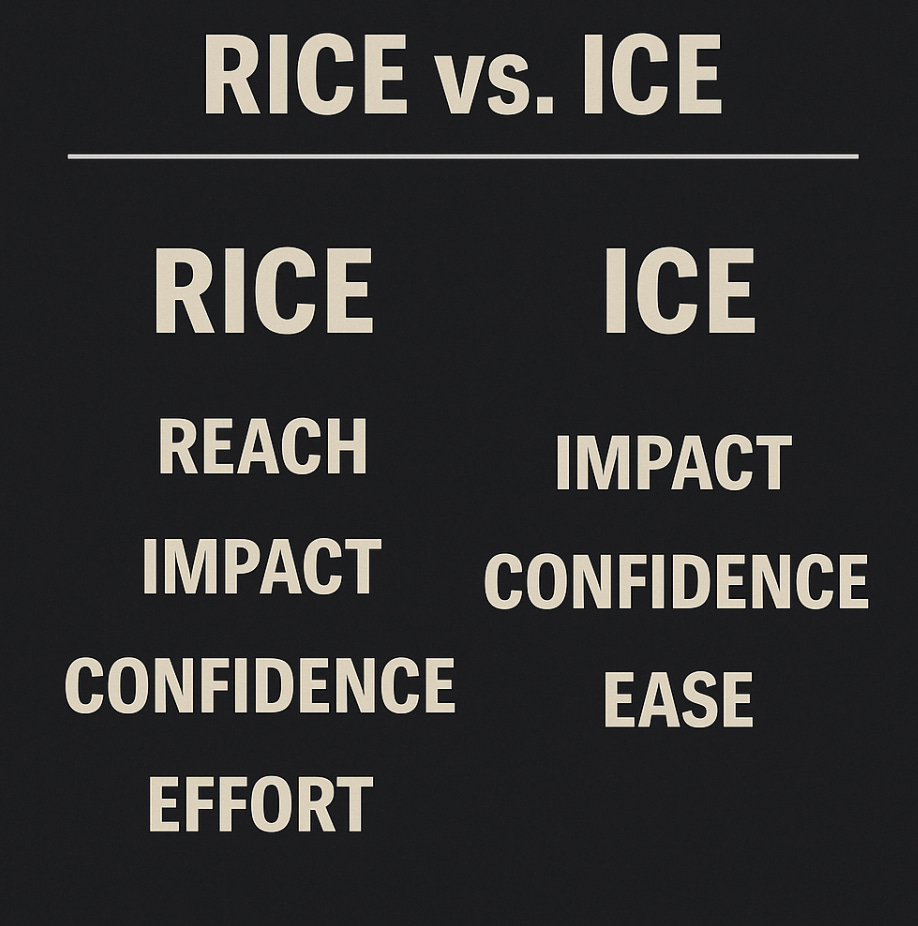Issue No.60: ICE and RICE in Strategy
not the physio version!
Let’s talk Strategy
One of my favourite things in strategy is understanding new concepts, as it allows me to join the dots together.
I relate this to my clinical days when I went on courses galore, every weekend, before undertaking a MSc too. I have a thirst for knowledge that allows me to then distil the information and utilise different models (or modalities!) at different times.
So, what is the newest model I wanted to explore this week? The Strategy version of ICE and RICE, not the physio version!
ICE vs RICE
In business strategy, execution is what counts but before you can execute, you have to decide, what’s actually worth doing?
ICE and RICE are two frameworks that can be used for this decision making process.
They are both scoring models used to prioritise ideas and projects - particularly when you’re juggling limited resources.
ICE is the minimalist tool that evaluates an idea based on three dimensions. It’s fast, intuitive, and ideal for early-stage teams or fast-moving environments:
Impact: How much will this move the needle if it works?
Confidence: How sure are we about our assumptions?
Ease: How simple or low-effort is it to implement?
ICE Score = (Impact × Confidence × Ease)
RICE adds one more dimension - the number of people affected. It is more precise and great for later-stage or cross-functional teams balancing multiple bets at scale.
Reach: How many customers/users will this impact?
Impact: How strongly will it affect them?
Confidence: How sure are we about the data or assumptions?
Effort: What will it take (in person-hours/days) to execute?
RICE Score = ((Reach × Impact × Confidence) / Effort)
Why impact, confidence and ease matter?
Whether you use RICE or ICE, the trio of impact, confidence, and ease/effort is important, as:
Impact ensures you’re solving meaningful problems, not just ticking boxes
Confidence saves you from falling in love with ideas that sound good but lack data or customer pull
Ease/Effort keeps you grounded in reality because the best idea is useless if your team can’t deliver it.
Final thoughts
Don’t get too caught up in the scores of these frameworks though - they are decision aids to help strategic conversations and dialogue.
You can use them to provoke questions like:
What would make us more confident?
Can we make this idea easier to test?
Is this solving a real problem?
In a world that demands urgency, ICE and RICE give you a way to move fast without being reckless. Because strategic clarity comes from making smarter bets, faster, and learning from them relentlessly.
What are your thoughts?
I partner with ambitious leaders and entrepreneurs scaling companies in Sports & Human Performance to provide Strategic consultancy.
Ready to uncover your path to purposeful sustainable growth? Let’s talk.
As always, if you enjoyed this content then feel free to share widely.
Nic x
Find me on Linkedin



